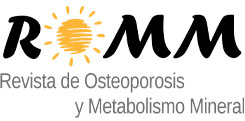Trabajo Original
Seguimiento y adherencia al tratamiento antiosteoporótico desde enfermería en una fracture liaison service
Leticia Cebollada Gadea, Raquel Laguna Rodrigo, Manuel Jordán Jarque, Rafael Izquierdo Aviñó
 Número de descargas:
30189
Número de descargas:
30189
 Número de visitas:
3008
Número de visitas:
3008
 Citas:
0
Citas:
0
Compártelo:
Introducción: la adherencia al tratamiento antiosteoporótico es fundamental para que la eficacia de los fármacos se reproduzca en la práctica clínica y es un objetivo prioritario para las fracture liaison service (FLS). Objetivos: describir el seguimiento y la adherencia al tratamiento de los pacientes atendidos por nuestra FLS, así como conocer las causas de finalización del seguimiento. Material y métodos: estudio descriptivo retrospectivo transversal de los pacientes > 50 años con fractura osteoporótica atendidos en una FLS de 2016 a 2020. Se realizó un análisis estadístico descriptivo de las variables recogidas mediante el programa SPSS. Resultados: la muestra fue de 1280 pacientes; el 86,2 % fueron mujeres y el 13,8 % hombres, de los cuales solo un 26,7 % habían recibido tratamiento antiosteoporótico previo. Tras la inclusión en la FLS hubo un incremento de un 59,6 % de pacientes a los que se les instauró tratamiento antiosteoporótico y, respecto al suplemento, hubo un aumento de un 42,6 %. Se llevaron a cabo cuatro seguimientos (a los 5,4 meses, 14,5 meses, 24,3 meses y a los 33,8 meses), obteniendo una buena adherencia al tratamiento del 72,1 %, 80,6 %, 83,1 % y 83,7 % respectivamente y de los suplementos del 90,1 %, 90 %, 88,2 % y 87,1 % respectivamente. Además, las causas de finalización de seguimiento fueron el cumplimiento del programa de seguimiento (21,48 %), éxitus (11,02 %), seguimiento por Atención Primaria (9,53 %), por decisión del paciente (6,48 %), por decisión médica (3,83 %), tratamiento no indicado (3,13 %) y por imposibilidad de realizar el seguimiento (2,73 %) Conclusiones: la inclusión de estos pacientes en una FLS refleja un alto porcentaje de buena adherencia y mejora el porcentaje de pacientes con fractura osteoporótica a los que se les instaura tratamiento. La causa más frecuente para la finalización del seguimiento fue su continuación por Atención Primaria.
Palabras Clave: Unidades de coordinación de fracturas. Fractura por fragilidad. Adherencia al tratamiento. Tratamiento antiosteoporótico. Gestora de casos.
DOI: 10.3390/ijerph16244902
DOI: 10.1016/j.ijsu.2017.09.010
DOI: 10.1016/j.afos.2016.09.002
DOI: 10.2147/CIA.S85551
DOI: 10.1177/1759720X18785539
DOI: 10.3390/ijerph15050944
DOI: 10.1007/s00198-015-3443-0
DOI: 10.1007/s00198-020-05358-4
DOI: 10.1016/j.bone.2018.03.018
DOI: 10.1177/1759720X17706464
DOI: 10.1007/s11657-020-0706-y
DOI: 10.1007/s00198-019-05104-5
DOI: 10.1016/j.afos.2018.11.084
DOI: 10.1016/j.afos.2017.05.001
DOI: 10.1038/s41598-017-10899-6
DOI: 10.1016/j.afos.2017.10.002
DOI: 10.1136/bmjopen-2018-027049
DOI: 10.1186/s12875-018-0828-0
DOI: 10.4321/S1889-836X2016000100003
DOI: 10.1002/jbmr.3990
DOI: 10.1007/s00198-012-2090-y
DOI: 10.1016/j.medcli.2013.11.014
DOI: 10.1007/s00198-015-3185-z
DOI: 10.1007/s00198-016-3643-2
Artículos Relacionados:
Trabajo Original: Descripción de los pacientes atendidos en la Escuela de Prevención de Fracturas y Caídas en el contexto de una Fracture Liaison Service. FLS Anoia
Carta Director: Cómo fusionar las unidades de ortogeriatría con las unidades de coordinación de fracturas (FLS). Experiencia en el Complejo Sanitario Joan XXIII de Tarragona
Editorial: Adherencia al tratamiento: un reto difícil pero posible
Trabajo Original: Riesgo de fractura osteoporótica mayor y de cadera en pacientes con accidente cerebrovascular en fase aguda. Estudio prospectivo multicéntrico
Editorial: La calculadora Garvan y el riesgo de fractura por fragilidad
Trabajo Original: Uso inadecuado de inhibidores de la bomba de protones y riesgo de fractura por fragilidad. Estudio preliminar
Trabajo Original: Impacto de las fracturas por fragilidad en mujeres españolas con osteoporosis posmenopáusica
Íñigo Etxebarria Foronda , José Ramón Cairo , Francisco Jesús Olmo Montes , María Jesús Moro Álvarez , Pilar Peris Bernal , Teresa Pareja , José Manuel Cancio Trujillo , Antonio Naranjo , Verónica Pérez del Río , Esteban Jódar , Manuel García Goñi , Josep Vergés , Stefano Maratia , Ignasi Campos Tapias , Laura Benedito Palos , Susana Aceituno
Artículos más populares
Trabajo Original: Resumen ejecutivo de las guías de práctica clínica en la osteoporosis postmenopáusica, glucocorticoidea y del varón (actualización 2022). SEIOMM
Esta versión actualizada de la Guía de osteoporosi...
Revisión: Acción de la cerveza sobre el hueso
Aunque se ha demostrado que el exceso de alcohol e...
-
Licencia creative commons: Open Access bajo la licencia Creative Commons 4.0 CC BY-NC-SA
https://creativecommons.org/licenses/by-nc-sa/4.0/legalcode

 Español
Español English
English


